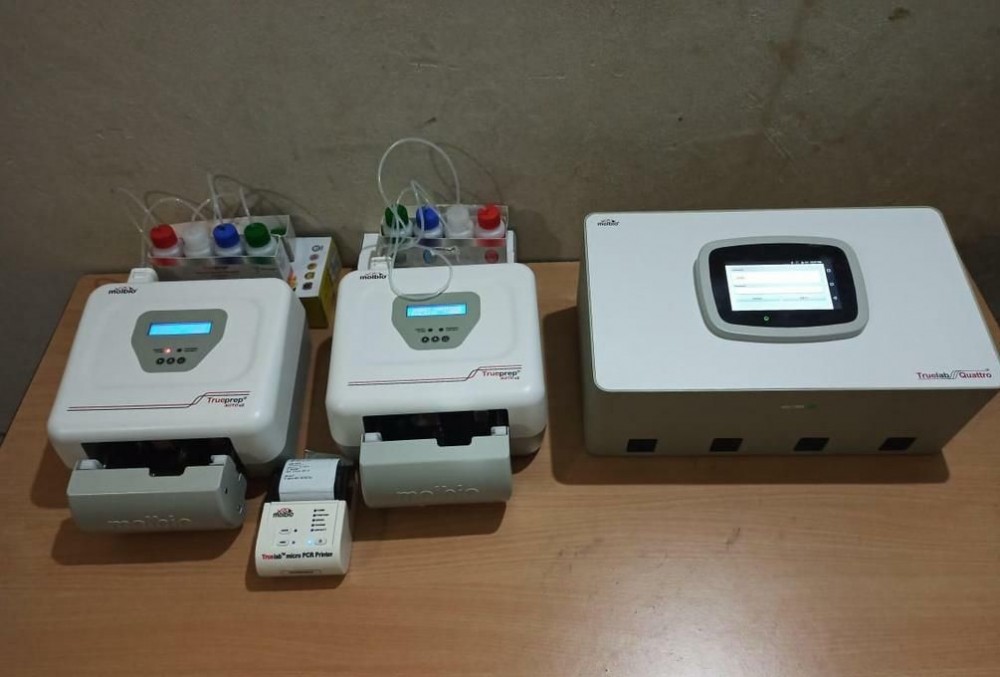The first batch of TrueNat machines which were installed at District Hospital, Dimapur, the designated COVID-19 Hospital for the district on June 5. More such machines would be installed in other districts later, informed Nagaland Health and Family Welfare Minister, S Pangnyu Phom in a tweet on June 5. (Photo Courtesy: @pangnyu / Twitter)

Imkong Walling
Morung Express News | Dimapur, June 5
State governments in India are reported to be in a rush for acquiring TrueNat machines. This rush is said to have been prompted by the Indian Council of Medical Research (ICMR) validating the use of the low-cost apparatus for testing COVID-19 samples in mid May.
The ICMR approval is regarded as a shot in the arm for shortening the time interval between collection (of samples), testing and results, while also lessening the load on BSL laboratories.
Prior to the ICMR green-signaling the use of TrueNat for confirmatory COVID-19 tests, it was only recommended for preliminary tests. Samples that tested positive by TrueNat had to be further validated by a full-fledged Bio Safety Level 2+ laboratory.
However, there has been a downside. According to people familiar with the workings of the medical sector in India, the recent rise in demand for TrueNat machines has had the state health departments jostling for it and giving way to a steep demand-supply gap.
In Nagaland, the COVID-19 Hospital in Mokokchung could acquire one but only in May.
No takers in 2013
“But the rush could have been avoided if only the health authorities recognized the machine’s potential when it was first launched sometime in 2013,” said one on condition of anonymity.
As on June 5, the Nagaland Health & Family Welfare Department had distributed one TrueNat machine each to the District Hospitals in Kiphire, Dimapur, Zunheboto, Phek, Wokha and two to Tuensang.
“I cannot say about the other states but there were not many takers in the north-east,” he said, while adding that the health authorities would have saved at least 30 percent in purchase cost.
At the time, only two private hospitals in Nagaland took interest in the machine acquiring one each.
Before India sounded the COVID-19 alarm or up till February, the price of the machine (excluding cartridges) was said to have been around Rs 5.5 lakh only to shoot up to at least Rs 6.6 lakhs after demands rose.
What is TrueNat?
The TrueNat machine, according to him, was designed as a multi-purpose diagnostic instrument which can detect a range of pathogens.
“It was launched as a micro, affordable RT-PCR machine, without compromising on quality, targeting smaller laboratories, nursing homes and the rural areas far from the reach of BSL laboratories,” he said.
COVID-19 was not in its diagnostic list when it was first launched some 7 years ago but given its adaptive and modular characteristics, he said that it had potential to expand the range of tests.
While stating, “It can handle (detect) H1N1, HBV, HCV, HIV, drug resistant TB, Dengue and JEV,” he added that when COVID-19 finally entered India and cases increased, it became apparent that the existing BSL laboratories would be stretched to the limit.
“That’s when R&D (research and development) into developing cartridges for sampling the new corona virus gathered steam, was evaluated by the ICMR and the subsequent approval,” he said.
Time-cost factor
A high-end TrueNat (Quattro) is said to have a capacity to test a maximum of 4 samples in an hour. Comparatively, he said that the time taken by a BSL 3 laboratory would average three and a half hours for 4 samples.
A BSL PCR can test a maximum of 96 samples in one go, returning results in 7 hours. In terms of scale, a BSL laboratory has the edge; however, he said that TrueNat can fit in where the number of suspected cases or samples is on the lower side. According to this reasoning, health workers in remote areas do not have to wait for samples to pile up to meet the required numbers to be sent for tests to the nearest BSL laboratory in bulk.
He added, “Truenat doesn’t require skilled workers, AC, deep freezers, as opposed to a conventional PCR in a BSL.”






